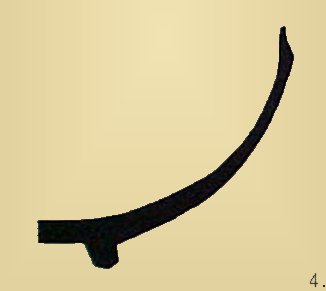| When trying to
substantiate whether or not a
piece is
from the Hongwu period, there are many areas to research. The best
tools available are research documents obtained from hands on
evaluation collected by knowledgeable individuals. In regard to Hongwu
porcelain, probably the best data available was gathered by the
Smithsonian Institute when one of the first and most detailed studies
ever of Fourteenth Century porcelain was conducted in 1950 at the
Topkapi Surrey Museum, Istanbul, Turkey, and at the Ardebil Shrine,
Tehran, Iran. This was done by the late John Alexander Pope.
John Alexander Pope was affiliated with the Smithsonian Institute for over 40 years and served as the Director of the Smithsonian's Freer Asian Arts Gallery from 1962 through 1971. He retired as director, yet remained as the Curator of Far Eastern Art until his death in 1982. He authored many books during his time and was considered by scholars as one of the best sources of knowledge in the field of Chinese Fourteenth Century blue and white porcelain. In 1952, two years after he conducted his study, he published his findings under the title: . Fourteenth Century Blue and White A Group of Chinese Porcelains in the Topkapu Sarayi Muzesi, Istanbul [publication1] This publication provided invaluable data towards the authentication of fourteenth century blue and white. Included in the publication are detailed descriptions of thirty-one pieces determined to be fourteenth century. Though the studies were conducted in 1950, it wasn't until 1956 that he published a second book: . Chinese Porcelain from the Ardebil Shrine [publication2] This large, detailed publication2 offers excellent research information on Chinese blue and white. The collection was started in 1587 by the Shah Abbas, and later added to by other Ottoman Turk rulers. Select pieces were chosen for the study to give a broad overall scope of the collection. Of the total 805 pieces in the collection, 618 are blue and white, and 320 of those are dishes. Of these dishes, mostly fifteenth and sixteenth century, there are 24 determined as belonging to the fourteenth century. It is among this small group of 24 dishes that I will base my comparisons to the Anhui Dish. In trying to be somewhat objective, here are some of my observations. In referring to both publications, I will make reference to each as publication1 or publication2 as shown above. . Style There seem to be three basic styles of rims known to Hongwu plates and dishes. They are flat, flat with foliate edge, and plain. I've chosen three from my collection for examples below. The first two are the most common, but those with a plain rim are extremely rare. Of the 24 known fourteenth century dishes in the Ardebil Shrine collection in Iran, there are none with a plain rim. There is however one in the Topkapi Surrey Museum collection.
. Shape and Size Shape and size play an important part in authentication. I've chosen Plate 3 from the first publication1 as a good comparison to start with. The reason being that it has the plain rim, the trellis-diaper band, which is also on 6 of the first 7 plates in the study, and a similar outline-wash to certain areas of the decoration. Page 49, Plate D of the first publication1 shows five different cut-away profiles of the large dishes and bowls in the Topkapi collection. Of these, Number 4 is in the style of the Anhui Dish. The depth of the dishes in the collection seems to average 3", with the diameter ranging from about 12" to just over 18". Figure 1. below is a scan from the book, figure 2 is the exact profile of the Anwui Dish. Only FireFox does it to scale, Chrome and Edge a bit smaller. |






